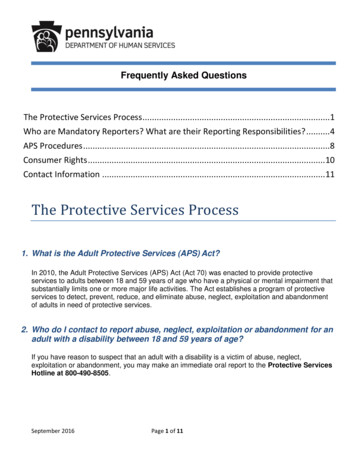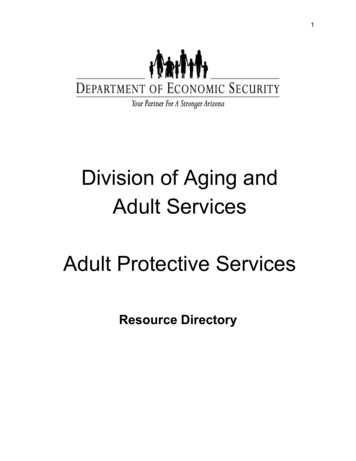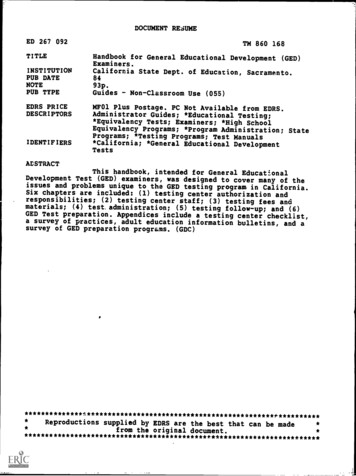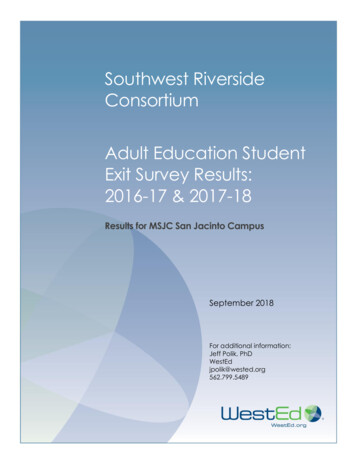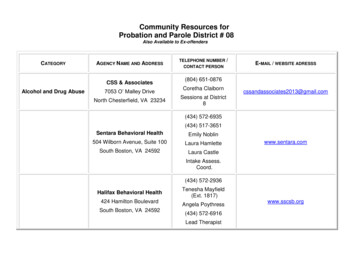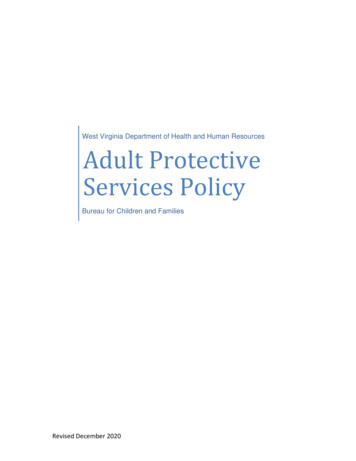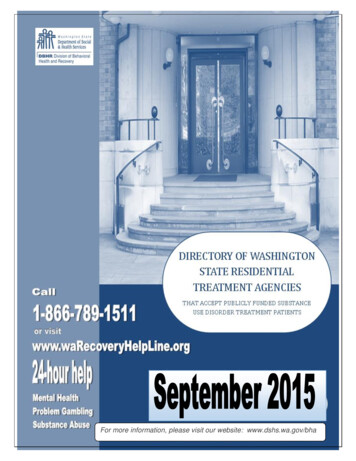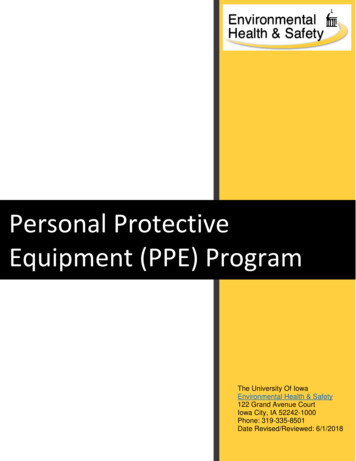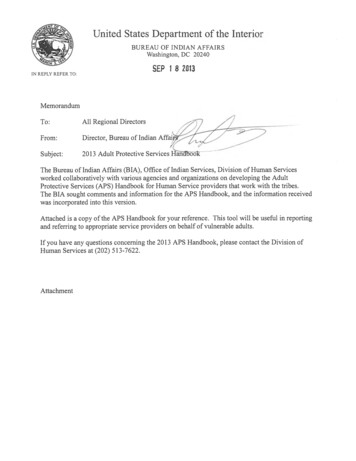
Transcription
United States Department o f the InteriorB U R E A U OF IN D IA N A F F A IR SW ashington, D C 20240SEP 1 8 2013IN REPLY REFER TO:MemorandumTo:All Regional DirectorsFrom:Director, Bureau of Indian AffairsSubject:2013 Adult Protective Services HandbookThe Bureau of Indian Affairs (BIA), Office of Indian Services, Division of Human Servicesworked collaboratively with various agencies and organizations on developing the AdultProtective Services (APS) Handbook for Human Service providers that work with the tribes.The BIA sought comments and information for the APS Handbook, and the information receivedwas incorporated into this version.Attached is a copy of the APS Handbook for your reference. This tool will be useful in reportingand referring to appropriate service providers on behalf of vulnerable adults.If you have any questions concerning the 2013 APS Handbook, please contact the Division ofHuman Services at (202) 513-7622.Attachment
2013Adult Protective Services HandbookA Guide for Protecting Vulnerable Adultand Elder Indians from Abuse, Neglect, and Exploitation
Table of ContentsAdult Protective Services: An Overview.1Relevant Legislation.2Accountability & Definitions.3Basic Eligibility and Services Offered.6Elder Abuse and Neglect.8Symptoms of Abuse/Neglect.9Examples of Abuse Incidents Reported.10Patterns and Trends Observed.11Financial Exploitation - A Trust Responsibility.12Reporting Abuse and Neglect of Elders and Vulnerable Adults in IndianCountry.13Prevention and Intervention in Abuse, Neglect, and Exploitation.15Restorative Justice Approaches And Programs.16Adult Protection Teams.17Operation Golden Shield.18Regional Map of the Bureau of Indian Affairs.20List of Regional Human Services Staff.21Adult Protective Services by Region.22Alaska Region.22Eastern Oklahoma Region.22Eastern Region.22
Great Plains Region.24Midwest Region.24Navajo Region.26Northwest Region.26Pacific Region.27Rocky Mountain.29Southern Plains Region.29Southwest Region.31Western Region.31Related Web Sites.33References.34Acknowledgements.35
Adult Protective Services: An OverviewThe Bureau of Indian Affairs (BIA) offers Adult Protective Services (APS) to Indian adultsas mandated by 25 Code of Federal Regulations (CFR), Part 20 Human Services, SubpartD, and Services to Children, Elderly, and Families. These are social services regulationswhose purpose is to protect any Indian or Alaskan Native adult who is the victim of analleged and/or substantiated incident of abuse, neglect, or exploitation.This handbook was developed in order to provide information about APS in IndianCountry. It is a resource guide containing information about elder and vulnerable adultabuse, listings for existing APS services, reporting procedures, and strategies foreliminating elder and vulnerable adult abuse.Original Cherokee Enrollee, Maggie McEachin and hergranddaughters, Martha & SusieStudies have shown that over 79% of elder abuse cases go unreported. (White, 2004)
Relevant Legislation18 U.S.C. §1151:Indian Country Defined18 U.S.C. §1152:The General Crimes Act (Laws Governing)18 U.S.C. pi 1.53:The Major Crimes Act (Offenses Committed within IndianCountry)18 U.S.C. §1162:State Jurisdiction Over Offenses Committed By Or AgainstIndians in the Indian Country25 U.S.C. §1408:Resources Exemption25 U.S.C. §14:Money Accruing to Indians from Department of Veterans Affairs orother Governmental Agencies25 U.S.C. §1403:Preparation of plan (plan for use and distribution plan)Public Law 280“Enacted in 1953, Public Law 82-280 (P. L. 280) shifted Federal jurisdiction overoffenses involving Indians in Indian country to six States and an option to assume suchjurisdiction. Affected tribes and States have faced obstacles in complying with thestatute, including jurisdictional uncertainty and insufficient funding for lawenforcement.” (Goldberg & Singleton, 2005)Mandatory StatesaOptional oNebraskaIowaOregonMontanaWisconsinNevadaNorth DakotaSouth DakotaUtahWashington
GUIDING PRINCIPLES OF APSP. L. 93-1 34, as amended by P. L. 97-458(25 U.S.C. §1401 et seq.)Provides for the distribution of JudgmentFunds to the parents or legal guardian ofAdults have the right to be safe.Adults retain their civil andconstitutional rights unless their rightshave been restricted by court action.such minors or legal incompetents in suchamounts as may be necessary for theminor or legal incompetents’ health,education, welfare, or emergencies under aplan or plans approved by the Secretaryand the tribal governing body of the Indiantribe involved.”Adults have the right to makedecisions that do not conform withsocietal norms, as long as they do notharm others.Adults are presumed to have decisionmaking capacity unless a courtadjudicates otherwise.Adults with cognitive capacity havethe right to accept or refuse services.Adults who appear to have impairedcognitive capacity must beprofessionally evaluated. If theimpairment is confirmed, APS,working with the courts, takes steps toprotect the person from harm.PURPOSE OF APSTo investigate reports o f abuse,neglect, and exploitation o f olderadults and, in most states, youngeradults with disabilities.To intervene and protect the victim tothe extent possible.AUTHORIZATIONAPS is statutorily authorized undertribal law and order codes as well asstate laws to receive and investigatereports o f elder abuse and, in themajority o f states, o f abuse o f youngeradults with severe disabilities, as wellas to protect the victims.
AccountabilityAll BIA, tribal, grant, contract, and self-governance programs are required to complywith existing federal laws. This includes the following requirements: backgroundinvestigations, mandatory reporting, failure to report penalties, confidentiality, andabuse investigation requirements or waivers.DefinitionsThe definitions used in this handbook are widely accepted definitions taken directlyfrom 25 C.F.R§20.100 and 18 U.S.C. §1151:A d u lt means an Indian person age 18 or older.Abuse means intentional or negligent infliction of bodily injury, unreasonableconfinement, intimidation, or cruel punishment of an elder or vulnerable adult withresulting physical harm or pain or mental anguish by any person, including anyonewho has a special relationship with the victim such as a spouse, child, or other relativerecognized by tribal law and custom, or a caretaker.Em otional Abuse means intentional infliction of threats, humiliation, or intimidation.Exploitation means the unauthorized or improper use of funds, property, or otherresources of an elder or vulnerable adult; or the unauthorized or improper use of theperson of the elder or vulnerable adult by a caretaker or by any other person forpersonal gain or profit; or the failure to use the funds, property, or other resources ofan elder to the elder or vulnerable adult’s benefit or according to the elder orvulnerable adult’s desires.Neglect means the failure of a caretaker to provide for the basic needs of an elder orvulnerable adult by not supplying resources, services, or supervision necessary tomaintain an elder or vulnerable adult’s (minimum) physical and mental health andincludes the inability of an elder or vulnerable adult to supply such basic needs for himor herself. Neglect is also interfering with delivery of necessary services and resources;failing to report abuse or neglect of an elder or vulnerable adult by any person; failingto provide services or resources essential to the elder or vulnerable adult’s practice ofhis customs, traditions, or religion.
Definitions (Continued)Indian means:Any person who is a member of an Indian tribe; orIn the Alaska service area only, any person who meets the definition of“Native” as defined under 43. U.S.C. 1602(b): “A citizen of the UnitedStates and one-fourth degree or more Alaska Indian (includingTsimshian Indians not enrolled in the Metlakatla Indian Community)Eskimo, or Aleut blood, or combination thereof. The term includes anyNative as so defined either or both of whose adoptive parents are notNatives. It also includes, in the absence of proof of a minimum bloodquantum, any citizen of the United States who is regarded as anAlaska Native by the Native Village or group of which he claims to be a memberand whose father or mother is (or, if deceased, was) regardedas Native by any Village or group. Any decision of the Secretary regardingeligibility for enrollment shall be final.”Indian C o u n trym a n s:all land within the limits of any Indian reservation under the jurisdiction of theUnited States Government, notwithstanding the issuance of any patent, and,including the rights-of-way through the reservation;all dependent Indian communities within the borders of the United Stateswhether within the original or subsequently acquired territory thereof, andwhether within or without the limits of a state; andall Indian allotments, the Indian titles to which have not beenextinguished, including rights-of-way running through the same.Indian Tribe means an Indian or Alaska Native tribe, band, nation, pueblo, village, orcommunity which is recognized as eligible for the special programs and servicesprovided by the United States because of their status as Indians.Local Law Enforcem ent A gency means that agency of the Federal government, of astate, or of an Indian tribe that has the primary responsibility for the investigation ofan instance of alleged abuse within the portion of Indian country involved.Protective Services means those services necessary to protect an Indian who is thevictim of an alleged and/or substantiated incident of abuse, neglect, or exploitation, orwho is under the supervision of the BIA in regard to the use and disbursement of fundsin his or her Individual Indian Money (IIM) account.
Sexua l Abuse means any physical contact with an elder or vulnerable intended forsexual gratification of the person making such contact and which is not consented toby the elder or vulnerable adult or for which the consent is obtained by intimidation orfraud.Social Services To Children, Elderly, A n d Fam ilies means social services, includingprotective services provided through the social work skills of casework, group work, orcommunity development to assist in solving social problems involving children,elderly, and families. These services do not include money payments.Basic Eligibility & Services OfferedWho is Eligible for Adult Protective Services (APS)?According to 25 C.F.R. §20.100 - §20.403, persons are eligible for Adult ProtectiveServices when he/she:1. Meets the definition of Indian as defined by 25 CFR § 20.100;2. Is over the age of 18 and disabled; or3. Is an elder (persons aged 55 and older); and4. Resides in the designated service area as defined in 25 CFR § 20.100;When are Adult Protective Services provided?Protective Services are provided for elders and disabled adults when they:1. Are deprived temporarily or permanently of needed supervision by responsibleadults2. Are neglected, abused, or exploited;3. Are in need of services when they are mentally or physically handicapped orotherwise disabled;4. Are under the supervision of the Bureau in regard to the use disbursement offunds in the adult’s Individual Indian Money (IIM) accountWhat does Adult Protective Services include?Coordinating with the relevant court system to provide services, which may include,but are not limited to the following:
1. Investigating and reporting on allegations of abuse and neglect, abandonment,and conditions that may require referrals (such as mental or physicalhandicaps);2. Providing social information related to the disposition of a case, includingrecommendation of alternative resources for treatment; and3. Providing possible placement services by the court order before and afteradjudication. Coordinating with other community services, including groups,agencies, and facilities in the community.Providing additional services, such as:1. Evaluating social conditions that affect community well-being;2. Working with other community agencies to identify and help clients to useservices available for assistance in solving the social problems of individuals,families, and elderly3 Coordinating with law enforcement and tribal courts, to place the victim of analleged and/or substantiated incident of abuse, neglect or exploitation out ofthe home to assure safety while the allegations are being investigated;4. Social services workers may request assistance from Law Enforcement to removeindividuals in life threatening situations. After a social services assessment, theindividual must be either returned to the home from which they were removedor the social services worker must initiate other actions as provided by the tribalcode; and providing social services in the home, coordinating and makingreferrals to other programs/services.
Elder Abuse and NeglectThe Need for Intervention in Indian Country“Elder abuse continues to grow as a national public concern. Because there arenumerous methods of sampling and surveying and several definitions of abuse, thebest estimates of elder abuse report that between one to two million elders over theage of sixty-five have been mistreated by someone upon whom they depend for careor protection. Little is known, however, about the abuse of elders in minoritypopulations. Even less is known about elder abuse, barriers to care, and social serviceneeds of elders in American Indian Communities.” (Anisko, 2009)Silence in the Indian Community“Mistreatment of an elder might be contrary to the role expectations of a tribalmember and could often go unsaid. Elders are valued in American Indian communitiesand are seen as bodies of wisdom and knowledge. To mistreat an elder would beconsidered acting against tribal expectations and disrespecting the culture. The eldersmay also feel deserving of mistreatment because they are not meeting their roleexpectations as an elder or family member and would become reluctant to mentionanything to a health care provider, friend, or family member. Reluctance to admit toany abuse or mistreatment by elders could also be caused by the fear of causing harmto their caretaker, normally a family member. In an attempt to protect and respect theircaretaker or family member, the elders would remain silent.” (Anisko, 2009)
Symptoms or Indicators of Abuse in Vulnerable Adults/EldersVulnerable Adults often times exhibit, fear, anxiety, agitation, anger, isolation,withdrawal, depression, non-responsiveness, resignation, ambivalence, contradictorystatements, implausible stories, hesitation to talk openly, or confusion and/ordisorientation when suffering from abuse. Below is a list of signs to look for whenassessing a vulnerable adult, however there may be other indictors and the list shouldnot be limited to the following;Physical SignsInjury that has not been cared forproperlyInjury that is inconsistent with theexplanation for its causePain when touchedCuts, puncture wounds burns,bruises, weltsDehydration or malnutritionwithout illness-related causePoor skin colorSunken eyes or cheeksInappropriate administration ofmedicationSoiled clothing or bedLack of necessities such as food,water, or utilitiesForced isolationUnsanitary living conditions: dirt,bugsAbsence of personal grooming orhygieneUnsuitable clothing or coveringfor weatherUnsafe living conditions (no heator running water; faulty electricalwiring, other fire hazards).EmotionalPersonally observing or receivingreports of threatening, belittling,or controlling caregiver behaviorBehavior from the elder orvulnerable adult that mimicsdementia, such as rocking,sucking, or mumblingSexualBruises around breasts or genitalsUnexplained venereal disease orgenital infectionsUnexplained vaginal or analbleedingTom, stained, or bloodyunderclothingHealth Care FraudDuplicate billings for the samemedical service or deviceEvidence of overmedication orunder medicationEvidence of inadequate care whenbills are paid in fullProblems with the care facility:Poorly trained, poorly paid, orinsufficient staffOvercrowding - Inadequateresponses to questions about careFinancial SignsFrequent expensive gifts fromvulnerable adult to caregiver;Vulnerable adult's personalbelongings, papers, credit cardsmissingNumerous unpaid billsA recent will when vulnerableadult seems incapable of writingwillSigning over deeds to propertyCaregiver's name added to bankaccountVulnerable adult unaware ofmonthly incomeVulnerable adult applying for orco-signing personal loans or creditpurchasesFrequent checks made out to"cash"Unusual activity in bank accountIrregularities on tax returnVulnerable adult unaware of reasonfor appointment with banker orattorneyCaregiver's refusal to spend moneyon vulnerable adultSignatures on checks or legaldocuments that do not resemble thesignature of the vulnerable adult.Environmental SignsAccumulations, hoardingInadequate shelterDrug paraphernaliaInadequate or spoiled foodOffensive odorsMultiple prescription bottles frommultiple doctors or pharmaciesInadequate sanitation for pets orVermin infestationUnusual weight loss, malnutrition,dehydrationUntreated physical problems, such asbed soresDesertion of an elder or vulnerableadult in a public placeAbuser TraitsPrevents vulnerable adult fromspeaking to or seeing visitorsAnger, indifference, aggressivebehavior toward vulnerable adultHistory of substance abuse, mentalillness, criminal behavior or familyviolenceLack of affection toward vulnerableadultFlirtation or coyness as possibleindicator of inappropriate sexualrelationshipConflicting accounts of incidentsSpeaks of vulnerable adult as aburdenBelieves vulnerable adult could domore self-care than actually capableof
Examples of Abuse Incidents Reportedfamily members could gain access to her income sources.Family members set up a methamphetamine lab in an elder’shome.A non-ambulatory elder was left without water or food and wasnot taken to her dialysis appointments.A son and daughter-in-law purposely overmedicated a wealthyolder woman with the purpose to cause her death.An elder was taken off dialysis and had her medicationswithheld as “punishment.”An elderly woman’s family forcibly inhabited her home, gainedaccess to her income and then placed her in a nursing homeagainst her will.After an elderly woman allowed her nephew and his family tomove into her home, her nephew coerced his aunt into signinga quit claim deed, thereby transferring ownership of theproperty to himAn elder voluntarily transferred ownership of her paid-offMutual Help home to her grandson, expecting that she wouldbe allowed to continue living there until she died. The grandsonsubsequently evicted her.An 85-year old woman reported to a domestic violenceprogram that her son had raped her.An elderly woman reported to her physician, whom she hadknown for many years, that she had been the victim of domesticviolence for 15 yearsTHE ABUSE MAY CONTINUE WITHOUT YOUR HELP.An elderly woman was removed from a nursing home, soIf you or someone you know has been abused, please report it today to the local authorities.(National Indian Council on Aging, 2004)
Patterns and Trends Observed(National Indian Council on Aging, 2004)Elder’s family members come to visit at the beginning of the month and either takeelders’ money or leave when the money runs out.Young children are left with elders who lack the strength or resources to providecare.Some elders have extremely valuable artifacts, including traditional clothing,baskets and beadwork, which is highly sought after by collectors. These assets aresometimes taken and sold by family members or others who have access to elders’homes. The care and control of these items can become a political issue involvingpeople outside the family because many tribal members do not believe these itemsshould be sold to outsiders.Family members threaten elders into signing over funds or become their “selfappointed” guardians.Indian grandparents who are the primary caregivers for grandchildren have littlesupport or assistance. In some cases, problems arise when the children reachadolescence. At this point, some begin to neglect, physically abuse or financiallyexploit their grandparents.Family members who want to provide care to elderly members lack adequateresources and time to do everything that is needed.Elders may be convinced to purchase items they do not need. Examples includemagazine subscriptions for elders who do not read or Medigap insurance policies.Elders, particularly those in remote areas, are isolated from family and friends.
Financial Exploitation - A Trust ResponsibilityIndividual Indian Monies (IIM) AccountsWhat are Individual Indian Money (IIM) Accounts?Beginning in the late 1800s, Indian land and resource assets were allottedto individual Indians. Funds earned from the use of these trust assetswere distributed to the individual beneficiaries of the land.In 1994, the American Indian Trust Fund Management Reform Actestablished the Office of the Special Trustee (OST) for American Indiansto improve the management and accountability of Indian trust funds heldby the Department of the Interior. One of OST’s responsibilities is tomanage financial trust assets for both Indian tribes and IIM accountholders.The BIA manages the trust property that generates income, as well asmanaging the non-income producing property. OST manages the incomethat is generated from the use of trust assets and ensures that the fundsare disbursed or invested and held in accounts for IIM beneficiaries.Whv are funds deposited into IIM accounts?Individuals who have an ownership interest in an income producing trustasset will have an IIM account. The lease income generated from thetrust resource may be, depending on the terms of the lease, collected bythe BIA and deposited into the trust system.What funds are deposited into IIM accounts?Money that is derived from the sale or use of trust lands, restricted feelands, or trust resources is deposited into IIM accounts under certaincircumstances as detailed in the regulations at 25 C.F.R. 11 5.701.What types of IIM accounts might an individual have?An individual may have several IIM accounts including:A “U” accountA Judgment accountA per capita accountA life estate account
What are Su p ervised IIM accounts?When a minor, or otherwise incapacitated adult/elder, has an IIM account,the BIA manages the IIM funds for these vulnerable adults and minors.Supervision is placed on the IIM trust account to ensure thedisbursements are for the benefit of the account holder. Additionally, theBIA wants to ensure that the account holder is protected from financialexploitation and financial mismanagement.Reporting Abuse and Neglect of Elders and Vulnerable Adults in Indian CountryAs a community, we have a legal and ethical obligation to report suspected abuse tolocal authorities: The Indian Child Protection and Family Violence Prevention Act, 25U.S.C. §3201 et seq.The Code requires that individuals in the following professions are required to reportsuspected incidents of elder or adult abuse (18 U.S.C. §1169).Medical NurseDental HygienistOptom etristM edical Exam inerEm ergency M edical TechnicianParamedicHealth Care ProviderOther ReportersC hild Day Care WorkerHead Start WorkerPublic Assistance WorkerCroup home, Day Care, orResidentialFacility WorkerSocial WorkerHuman Services ProfessionalsCase ManagersPsychiatristPsychologistPsychological AssistantMarriage or Fam ily CounselorMental Health ProfessionalsLaw Enforcem ent O fficerProbation OfficerPublic Agency Sta ff Who AreResponsible For EnforcingStatues andJ u d icia l Orders
How to REPORT elder/disabled adult abuse:To report elder/disabled adult abuse,contact federal and state local lawAccording to the National AdultProtective Services ResourceCenter:enforcement and tribal/agency socialservices program staff.In the case of an emergency Dial 9-1-1Elder Abuse is common, lethal,and expensive.Victims and families lose lifetimesavings, often almost overnight,and may suffer physical andWho may report elder/disabled adultabuse:other types of abuse related toexploitation.Financial institutions loseAny person may report elder/disabledadult abuse. This includes family members,neighbors, friends, and any concernedcitizen.significant amounts in deposits;money which is seldomrecovered.In one study, almost one in tenfinancial abuse victims turned toMedicaid as a direct result oftheir own monies being stolenfrom them.Abused seniors are three timesmore likely to die prematurely.Elder abuse victims are fourtimes as likely to go into anursing home.Elder abuse is vastlyunderreported. Only one in 23cases is reported to any agency;for financial abuse only one in 44cases is reported for neglect onlyone in 57 cases is reported.END THE CYCLE. BREAK THESILENCE.90% of abusers are familymembers or trusted others.Over 95% of seniors live in thecommunity and not in elder carefacilities.
Prevention and Intervention in Abuse, Neglect and ExploitationIn o rd e r to p re ve n t e ld e r a n d d isa b le d a d u lt abuse, we m u st attem pt to u n d e rsta n d the ca u seso f it.Causes of AbuseElder abuse may arise from an abuse of power and a sense of entitlement by theabuser. (White, 2004)Caregivers who are unhappy, frustrated, easily angered, and who feel entitled tolash out at others with less power may be more likely to commit some extremeforms of elder abuse. (White, 2004)Factors That May Contribute To Mistreatment (Anisko, 2009; White, 2004)Stress of the caregiver.Stress of the victim.Caregiver alcohol/drug use.Psychological illness in the home/caregiver residence.Marital conflict/domestic violence.Financial dependence of the caregiver on the elder.Multiple caregivers.Medication noncompliance.Ways to Reduce the Possibility of AbuseBecome involved in your own community:Seek community/tribal respite care services.Hold public awareness meetings.Sponsor seminars that educate family members on how to care for eldersand disabled adults.Reach out to others:If you suspect elder/disabled adult abuse, report it as soon as possible.Make an effort to regularly check on any elder or disabled adult you knowwho may be isolated or lonely.Learn more about Tribal/regional resources:If you have any questions about APS within your region, contact yourRegional Social Worker. (See page 20) for a list of all Regional SocialWorkers)
Restorative Justice Approaches and ProgramsAn Alternative Approach to Justice“Peacemaker courts and other traditional approaches to justice have attracted attentionwithin and beyond Indian country. “Restorative justice” approaches, patterned afterIndian and native justice traditions, have received widespread attention by criminaljustice and corrections professionals and victims advocates in Canada, New Zealand,and, increasingly, in the United States (Bilchik, 1998). The approach addresses crimeand abuse as violations of relationships rather than simply as infractions of the law.Restorative justice approaches involve victims, offenders, the families of victims andoffenders, and communities in the search for solutions. They consider why abusehappened, what can be done to repair the harm, and what can be done to prevent itfrom happening again. Restorative justice techniques include:Family Group/Community Conferencing.
Who is Eligible for Adult Protective Services (APS)? According to 25 C.F.R. §20.100 - §20.403, persons are eligible for Adult Protective Services when he/she: 1. Meets the definition of Indian as defined by 25 CFR § 20.100; 2. Is over the age of 18 and disabled; or 3. Is an elder (persons aged 55 and older); and
